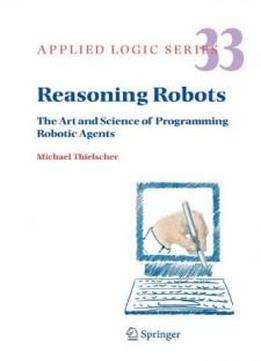
Reasoning Robots: The Art And Science Of Programming Robotic Agents (applied Logic Series)
by Michael Thielscher /
2010 / English / PDF
4.2 MB Download
The book provides an in-depth and uniform treatment of a
mathematical model for reasoning robotic agents. The book also
contains an introduction to a programming method and system based
on this model.
The book provides an in-depth and uniform treatment of a
mathematical model for reasoning robotic agents. The book also
contains an introduction to a programming method and system based
on this model.
The mathematical model, known as the "Fluent Calculus'',
describes how to use classical first-order logic to set up
symbolic models of dynamic worlds and to represent knowledge of
actions and their effects. Robotic agents use this knowledge and
their reasoning facilities to make decisions when following
high-level, long-term strategies. The book covers the issues of
reasoning about sensor input, acting under incomplete knowledge
and uncertainty, planning, intelligent troubleshooting, and many
other topics.
The mathematical model, known as the "Fluent Calculus'',
describes how to use classical first-order logic to set up
symbolic models of dynamic worlds and to represent knowledge of
actions and their effects. Robotic agents use this knowledge and
their reasoning facilities to make decisions when following
high-level, long-term strategies. The book covers the issues of
reasoning about sensor input, acting under incomplete knowledge
and uncertainty, planning, intelligent troubleshooting, and many
other topics.
The mathematical model is supplemented by a programming method
which allows readers to design their own reasoning robotic
agents. The usage of this method, called "FLUX'', is illustrated
by many example programs. The book includes the details of an
implementation of FLUX using the standard programming language
PROLOG, which allows readers to re-implement or to modify and
extend the generic system.
The mathematical model is supplemented by a programming method
which allows readers to design their own reasoning robotic
agents. The usage of this method, called "FLUX'', is illustrated
by many example programs. The book includes the details of an
implementation of FLUX using the standard programming language
PROLOG, which allows readers to re-implement or to modify and
extend the generic system.
The design of autonomous agents, including robots, is one of the
most exciting and challenging goals of Artificial Intelligence.
Reasoning robotic agents constitute a link between knowledge
representation and reasoning on the one hand, and agent
programming and robot control on the other. The book provides a
uniform mathematical model for the problem-driven, top-down
design of rational agents, which use reasoning for decision
making, planning, and troubleshooting. The implementation of the
mathematical model by a general PROLOG program allows readers to
practice the design of reasoning robotic agents. Since all
implementation details are given, the generic system can be
easily modified and extended.
The design of autonomous agents, including robots, is one of the
most exciting and challenging goals of Artificial Intelligence.
Reasoning robotic agents constitute a link between knowledge
representation and reasoning on the one hand, and agent
programming and robot control on the other. The book provides a
uniform mathematical model for the problem-driven, top-down
design of rational agents, which use reasoning for decision
making, planning, and troubleshooting. The implementation of the
mathematical model by a general PROLOG program allows readers to
practice the design of reasoning robotic agents. Since all
implementation details are given, the generic system can be
easily modified and extended.











